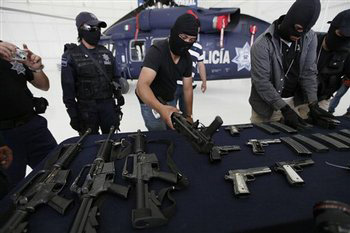
|  |  |  News Around the Republic of Mexico | April 2009 News Around the Republic of Mexico | April 2009  
Mexican Arms Race: Bigger Guns for Drug Cartels
 Alexandra Olson - Associated Press Alexandra Olson - Associated Press
go to original


| | Police remove weapons that were seized from suspected drug traffickers after presenting the weapons and the suspects to the press at the federal police headquarters in Mexico City, Sunday, April 19, 2009. During a police operation Saturday against the Michoacan-based drug cartel known as La Familia, or, "The Family," 44 people were detained during a baptism in Morelia, Mexico, according to federal police. (AP/Gregory Bull) |  |
Mexico City — An escalating arms race among Mexico's drug cartels casts doubt on whether Mexico or the U.S. can stop the flow of weaponry, despite renewed vows last week from presidents of both countries.

Stockpiles captured by Mexican soldiers show that warring traffickers are now obtaining military-grade weaponry such as grenades, launchers, machine guns, mortars and anti-tank rockets.

Some drug gangs have even sought explosive material that some experts worry could be used in car bombs and improvised explosive devices of the kind used in Iraq and Afghanistan. Soldiers found 14 sticks of TNT among an arsenal of hundreds of rifles and grenades seized in November from a house in Reynosa, across the border from McAllen, Texas.

But so far, attempts at using bombs have been unsuccessful as drug gangs haven't yet developed the skills to build effective ones, said Stephen Meiners, a Latin America analyst with Stratfor, a private U.S.-based group. Authorities suspect the Sinaloa cartel tried to kill a Mexico City police officer last year with a homemade bomb that killed only the attacker.

"Once you have a bomb maker that has mastered that skill, unless that bomb maker is caught, he can keep constructing those devices and send them out to be deployed," he said.

One of the most worrisome weapons yet was seized this week just south of Nogales, Ariz.: a powerful gun mounted on the back of an SUV and protected by a thick metal shield. Police said it belonged to one of the Beltran Leyva drug gangs.

Mexican and U.S. authorities disagree on just what type of gun it was. Federal police coordinator Gen. Rodolfo Cruz maintains it was .50-caliber anti-air craft machine gun. ATF, the U.S. Bureau of Alcohol, Tobacco, Firearms and Explosives, said it was an unmodified .50-caliber semiautomatic rifle made by TNW, a U.S. firearms manufacturer.

ATF investigators traced the gun – along with seven others seized at a house in Sonora state on Monday – to suppliers in the United States, said Bill Newell, special agent in charge of the ATF in Arizona and New Mexico.

While crudely built, the truck-mounted rifle would give traffickers a powerful advantage against lightly armed police, Newell said: A gunman could protect a whole convoy with sweeping fire while protected by the metal shield.

"Imagine being a two- or three-man police team at a rural checkpoint and these guys roll up with this thing," Newell said. "You'd be slightly intimidated, wouldn't you?"

President Barack Obama says he will crack down on the smuggling of weapons easily purchased lawfully in the United States and then taken to Mexico, which has strict gun-control laws.

But Mexico's drug gangs are clearly digging in for this war, which has already claimed more than 10,670 lives since Calderon deployed 45,000 troops to confront the cartels at the beginning of his presidency in December 2006.

Even as the governments try to choke off the U.S. weapons supply, the gangs are clearly trying to expand their arsenals beyond the assault rifles and semi-automatics they can get in the United States.

These and other, much heavier weapons are readily available on the global black market, particularly from stockpiles left over from Central America's civil wars.

Civilians are increasingly being targeted. In October, assailants hurled a grenade at the U.S. consulate in the northern city of Monterrey. In January, a TV network's offices in the same city were attacked.

The grenades used in both attacks were similar to one thrown into a nightclub in Pharr, Texas, in January, according to the ATF. That one didn't explode.

The agency suspects they came from a Monterrey warehouse where the Gulf cartel had been stockpiling weapons, including South Korean-made K75 fragmentation grenades.

The cartels are still far from obtaining enough arms and training to overpower Mexico's military, which is much better weapons coordination, Meiners said.

On Wednesday, only hours before Obama's visit, 15 gunmen were killed but only one soldier died when a convoy of armed men fought with troops patrolling a drug trafficking hotbed in remote, mountainous Guerrero state.

But local police are outgunned and have left the battle to the military – showing how hard it will be to achieve what Mexican President Felipe Calderon and Obama agreed will be success – a drug war which local police can handle without military help.

"We only have 20 police, and we cannot risk entering in operations against the narcos," said Santiago Bustos, the second-in-command of the police in San Nicolas del Oro, where Wednesday's shootout happened. |

 |
|  |



